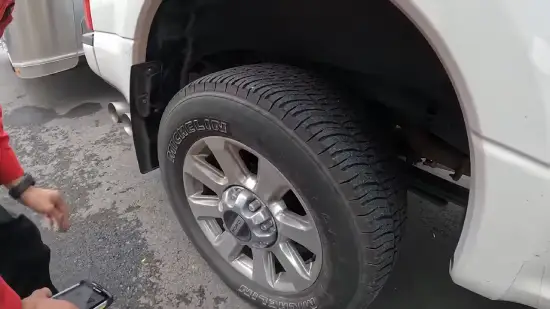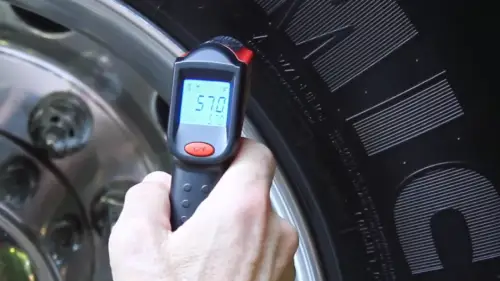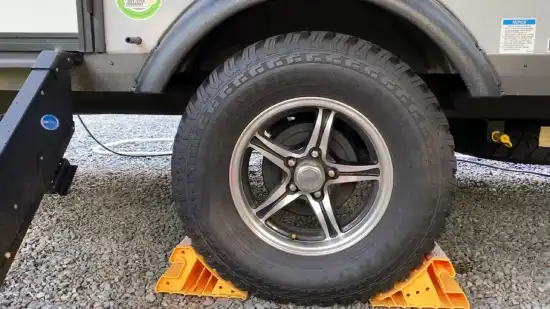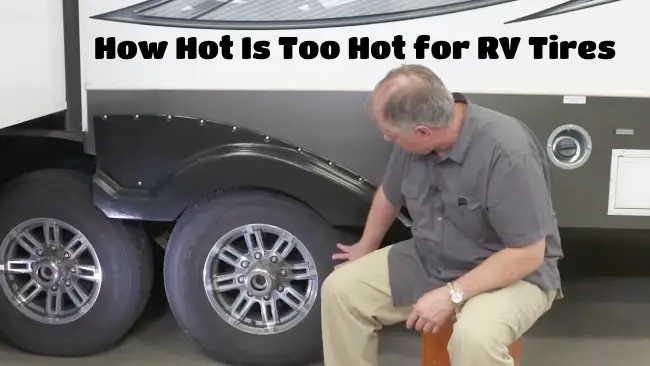Last Updated on July 5, 2023
RV tires are often overlooked but are crucial to a successful road trip. That being said, they are not invulnerable to road wear and tear. Excessive heat is one of the primary culprits in speeding up the aging process of RV tires.
Understanding the safety thresholds for tire temperature to keep your vehicle in tip-top shape and prevent unexpected roadside breakdowns is essential. The critical threshold lies between 160 to 195 degrees Fahrenheit.
Due to the unpredictable nature of weather on the open road, it is essential to understand the causes of overheating in RV tires. Today, we strive to enlighten our readers on the potential risks involved and present practical measures to mitigate the damage that overheating can cause to RV tires.
What Happens When RV Tires Exceed the Safe Temperature Range?

RV tires are designed to operate within a specific temperature range. When the temperature exceeds the recommended limit, several negative consequences may occur.
- Structural Damage
- Tread Reversion
- Decreased Strength
- Increased Wear
- Increased Risk of Blowouts
- Reduced Handling and Stability
- Safety Risks
## Structural Damage
Excessive heat can lead to the breakdown of rubber compounds within tires, resulting in structural damage to the internal components. Tires’ internal structure weakens when the temperature exceeds the optimum temperature, causing the rubber compounds to break down.
This breakdown can cause cracks in the tire’s surface, eventually leading to tire failure. Moreover, the heat weakens the tire’s steel belts, which can cause the tire to misshapen or lose its shape altogether, leading to a blowout.
Tires with weakened internal components are more likely to develop bulges or blisters on their surface, which can cause further damage if left unattended.
## Tread Reversion
The rubber compounds in a tire can distort when temperatures exceed recommended ranges, causing tread reversion. This occurs when the tire’s tread loses its shape and becomes deformed, affecting its ability to maintain traction on the road.
Tread reversion can have significant consequences, including increased stopping distances and reduced overall performance of the tire. According to a study by the National Highway Traffic Safety Administration, tires with tread reversion can increase stopping distances by up to 30%.
This is because the tire is unable to maintain proper contact with the road, reducing its ability to stop the vehicle in an emergency situation effectively.
## Decreased Strength
Elevated temperatures can impair the tire’s durability, increasing vulnerability to punctures, blowouts, and other failures. The excessive heat causes the rubber compounds to break down, reducing the tire’s strength. Heat accelerates the aging process of rubber, making it brittle and lose its elasticity.
As a result, the tire is more prone to damage and may fail prematurely. The decreased strength of the tire due to excessive heat can be attributed to oxidation and thermal degradation. Rubber oxidizes when it reacts with oxygen molecules in the air, causing chemical changes in the rubber that break it down.
On the other hand, thermal degradation happens when the rubber is exposed to high temperatures, causing the polymer chains to break down into shorter ones. Both of these processes contribute to the weakening of the tire and can lead to various problems, including tread separation, blowouts, and other failures.
## Increased Wear
Extreme temperatures accelerate the erosion of the rubber, resulting in a significant reduction in the tire’s lifespan. This increased wear is due to several factors, including increased friction between the tire and the road surface and additional pressure on the tire as it heats up.
Due to its softer and more pliable nature, rubber can wear down quickly and develop cracks and other damage when heated.
To better understand the effects of high temperatures on tire wear, consider the following table:
| Temperature Range | Effects on Tire Wear |
| Below 70°F | Minimal wear |
| 70°F to 100°F | Normal wear |
| 100°F to 120°F | Increased wear |
| Above 120°F | Severe wear and potential for tire failure |
## Increased Risk of Blowouts
Increased wear is not the only concern when it comes to RV tires. The heat generated by prolonged vehicle use can cause the tire temperature to exceed safe levels. This can increase the risk of blowouts, which can be extremely dangerous for the driver and passengers.
To better understand the risks associated with high tire temperatures, consider the following points:
- Tire blowouts become more likely when the tire temperature exceeds the safe range.
- The heat can cause the tire to weaken and may result in a sudden failure, leading to loss of control over the vehicle.
- High temperatures can also cause the rubber to degrade more quickly, reducing the overall lifespan of the tire.
- Regular RV maintenance, including regular inspections and proper inflation, can help reduce the risk of blowouts and keep tires from melting.
## Reduced Handling and Stability
Excessive heat generated by prolonged vehicle use can negatively impact the handling and stability of RV tires. Overheated tires can exhibit decreased handling and stability, making it difficult for the driver to maintain vehicle control.
In emergencies, where quick and precise maneuvers are imperative to avoid accidents, this can be particularly problematic. Furthermore, overheated tires can make it harder for the vehicle to maneuver safely. This can increase the risk of accidents, particularly in wet or slippery conditions.
## Safety Risks
Reduced handling and stability are two significant concerns for RV tire users when operating their vehicles. However, the risks associated with exceeding the safe temperature range of RV tires are far more severe. Such risks pose a significant safety hazard to the occupants of the RV and other vehicles on the road.
Blowouts or loss of control due to tire failure can lead to accidents with severe consequences. To understand the safety implications of overheating RV tires, it is essential to examine the effects of heat on tire performance.
As the tire’s temperature increases, the tire’s structural integrity weakens, leading to a higher risk of failure. The table below highlights the effects of temperature on tire pressure and the associated risks.
| Temperature | Tire Pressure | Risks |
| Below 70°F | Decreases | Reduced traction and control |
| 70°F – 100°F | Increases | Wearing of tire tread |
| Above 100°F | Increases | Blowouts and loss of control |
What Can Be Done to Prevent RV Tires From Reaching Dangerous Temperatures?

To maintain safe RV tire temperatures, several key points should be considered.
1. Monitor Tire Pressure
Monitoring and maintaining tire pressure according to the manufacturer’s recommendations is crucial to ensure your RV tires perform well. When RV tires are underinflated, they generate more heat, which can cause significant damage to the tire structure and lead to premature failure.
This is because underinflated tires have a smaller surface area in contact with the road, causing the tire to flex more than it should. When the tire flexes, it generates more heat, which can cause the tire to break down and ultimately fail.
RV owners should regularly check their tire pressure and keep it within the recommended range to avoid this. This can be done using a tire pressure gauge and adjusting the pressure as necessary.
Note: Also, checking tire pressure before a long trip or when the weather changes are essential since temperature fluctuations can affect tire pressure.
2. Avoid Overloading
To ensure the safety and longevity of RV tires, consider the tire manufacturer’s maximum weight capacity or the vehicle’s weight rating. Overloading can cause tires to overheat, leading to blowouts or other safety hazards. RV owners must avoid overloading their vehicles with too much weight.
When RV tires are subjected to excessive weight, they generate a significant amount of heat, which can cause the rubber to break down and weaken over time. As the tires continue to heat up, they can become susceptible to punctures, blowouts, and other types of damage.
To prevent this, it is always important to check the weight capacity of the tires and the vehicle and to avoid exceeding those limits whenever possible. By doing so, RV owners can help ensure their and their passengers’ safety while on the road.
3. Control Speed
Driving slowly can prevent excessive heat buildup and ensure the longevity of your RV’s tires, which can ultimately affect the safety of your passengers. When driving at high speeds, the tires generate more heat, which can cause them to wear out faster and even lead to a blowout.
Avoid driving too fast and stick to moderate speeds to prevent this. Controlling your speed is crucial for your RV’s tires for three reasons:
- High speeds generate more heat in tires, causing them to wear out faster.
- Excessive heat buildup can lead to tire blowouts, which can be dangerous and expensive to fix.
- Driving at moderate speeds can help distribute the weight of your RV more evenly, reducing the strain on your tires and preventing premature wear and tear.
4. Limit Sun Exposure
Control speed is essential in ensuring your RV tires’ longevity. However, there are other factors that you should consider. Direct sunlight can also have a significant impact on your tires’ condition. Exposure to sunlight can increase tire temperature and accelerate the aging process, leading to tire failure.
Therefore, it is crucial to limit sun exposure as much as possible. One way to limit sun exposure is to park your RV in shaded areas. If you cannot find a shaded area, you can use tire covers to protect the tires from direct sunlight. Tire covers protect your tires from UV rays and other environmental factors that can damage them.
The table below summarizes the effects of sun exposure on tire temperature and lifespan.
| Sun Exposure | Tire Temperature | Lifespan |
| Direct | Increases | Decreases |
| Indirect | Slightly increases | Slightly decreases |
5. Monitor Ambient Temperature
Monitoring the ambient temperature is a crucial aspect of maintaining the health and longevity of your vehicle’s tires. High ambient temperatures can contribute to tire overheating, leading to a tire blowout. Remember, ambient temperature means the air around the tires, not just the road temperature.
To monitor the ambient temperature of your RV tires, consider using a tire pressure monitoring system (TPMS). A TPMS can measure the temperature of each tire, allowing you to identify any tires that are overheating.
It is also important to consider the time of day and location when monitoring the ambient temperature. For example, temperatures may be cooler in the morning or evening, and driving through a shaded area may provide some relief from the heat.
6. Maintain Proper Wheel Alignment
Proper wheel alignment helps maintain an even load distribution and minimize tire temperature, prolonging the life of your RV’s tires. You’ll reduce the risk of uneven tire wear and overheating when your RV’s wheels are aligned correctly. Alignment also reduces tire strain and prevents excessive heat buildup.
Maintaining proper wheel alignment involves several important steps. To begin with, a professional should check your RV’s alignment regularly. This will help identify any misalignments that may be present and allow you to correct them before they cause significant damage.
Additionally, you should ensure that your RV’s tires are properly inflated and that the weight distribution is even throughout the vehicle. Also, you should avoid overloading your RV or carrying more weight on one side than the other, which can cause uneven tire wear.
Is it a good idea to keep your RV tires inflated when the weather is hot?

Maintaining proper tire inflation in an RV during hot weather is crucial to prevent poor handling, longer stopping distances, and uneven tire wear. When the air inside the tire expands due to the rising temperature, it is important to check and adjust the tire pressure accordingly.
It is recommended to use a tire pressure gauge to check the pressure when the tires are cool, preferably in the morning before driving. Overinflated tires can result in a harsh ride, reduced traction, and increased risk of a blowout, whereas underinflated tires can cause overheating and premature tire failure.
Refer to the manufacturer’s tire pressure chart in the owner’s manual or on the tire sidewall to determine what tire pressure is right for your RV. It is important to note that the maximum tire pressure listed on the tire sidewall should not be exceeded, even in hot weather.
Additionally, it is not recommended to decrease tire pressure to increase the tire’s surface area and thus improve traction. The result can be uneven tire wear, poor handling, and longer stopping distances.
How long does it take for RV tires to cool down?
After driving an RV, waiting at least three hours for the tires to cool down before checking their pressure is recommended. The friction generated by driving heats up the tires, which can cause inaccurate pressure readings. Inaccurate readings can be dangerous, leading to over-inflated or under-inflated tires.
According to the National Highway Traffic Safety Administration, properly inflated tires can reduce the risk of tire-related accidents by up to 11%. Therefore, it is important to check the tire pressure of your RV regularly, especially after driving, to ensure its safety on the road.
Waiting for the tires to cool down is particularly important during hot weather conditions. The heat generated by the sun can cause the tires to expand, leading to increased pressure levels. As a result, it is recommended to keep the RV tires inflated to the manufacturer’s recommended pressure levels during hot weather.
It is also recommended to park the RV in the shade during hot weather to prevent the tires from overheating.
Is it better to have air or nitrogen in RV tires?
The choice between using air or nitrogen in the tires of an RV can have a significant impact on various factors related to tire performance. Nitrogen is known to keep the proper tire pressure longer, so RV owners can spend less time filling their tires.
Nitrogen-filled tires also last longer and offer better fuel economy as they maintain consistent pressure over time. Additionally, nitrogen fill systems are dry and do not dispense water vapor into the tire, which can cause issues such as rust and corrosion.
While nitrogen has its benefits, it is important to note that it may not be necessary for all RV owners. The primary advantage of using nitrogen is that it reduces the amount of oxygen in the tire, which can slow down the process of oxidation and prevent tire aging.
However, many RV tires are not exposed to prolonged periods of sunlight or high temperatures, which primarily causes tire aging. Therefore, if an RV owner stores their vehicle in a cool, shaded area, they may not need to use nitrogen in their tires.
Ultimately, using nitrogen or air in RV tires depends on the owner’s preferences and driving habits.
RV Tire Maintenance: Keep Your Tires Cool for Safe Travels

Ensuring that RV tires are well-maintained is a formal affair. Exceeding the temperature range can have dire consequences. Blowouts and tread separation can occur when the tire deteriorates from too much heat exposure. Taking the necessary steps to prevent overheating is the key.
Avoiding overloading, driving at safe speeds, and checking tire pressure are crucial measures. Additionally, using tire covers and parking in the shade help to cool the tires. A watchful shepherd always tends to their flock, and a responsible RV owner should always keep an eye on the health of their tires.
All in all, it is important to remember that keeping tires cool is essential to prevent dangerous situations on the road.



